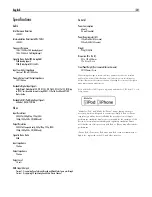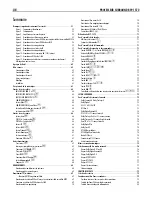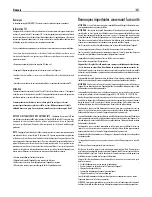
36
RSP-1572 SURROUND SOUND PROCESSOR
Press the ENT button on the remote to confirm that letter and move
2.
to the next position.
Repeat steps 1 and 2 until all eight characters (including blank
3.
spaces) have been completed. The final press of the ENT button
saves the new label.
AUDIO INPUT:
assigns a physical input connection to use as the default
for the source displayed in the first line of the menu. Can be OPTICAL
1–4, COAXIAL 1–3, ANALOG or HDMI Audio.
Note:
HDMI Audio input is assigned to a specific VIDEO input.
When a digital input is the default, the unit will check for a digital signal
when the INPUT SOURCE is selected. If no digital signal is present, the
unit will automatically revert to the analog input.
When an ANALOG input is the default, the unit will not access a digital
signal, even though one may be present at the digital input; thus, the
ANALOG setting forces the unit to use an analog signal. Assigning a
digital input (with its auto-sensing) is generally the preferred configuration
for any source with a digital output.
INPUT ATT:
the audio INPUT ATT function allows you to reduce the
level of the selected audio input from 0dB to –6dB, in 1dB steps. Use this
attenuation for louder sources to match them to quieter sources.
Note:
If a source connected to a digital input is selected, that signal will
automatically be sent to both digital outputs for recording.
CINEMA EQ:
The RSP-1572 includes a CINEMA EQ feature which
reduces the high-frequency content of movie soundtracks to simulate the
frequency response of a large movie theater and/or eliminate sibilance.
You can turn the CINEMA EQ on or off as the default setting for the selected
input using this menu choice. In general, this setting should be OFF for
most source inputs, unless you are consistently bothered by excessively
bright sound from movie soundtracks.
12V TRIGGER:
The RSP-1572 has six 12V trigger outputs (labeled
1–6) that supply a 12V DC signal to turn on Rotel components and other
components as needed. This menu item turns on specific 12V trigger
outputs whenever the indicated source is selected. For example, set up
the VIDEO 1 input to turn on the 12V trigger for your DVD player. Any
combination of trigger outputs can be programmed for each source.
Press the Left/Right buttons on the remote to change the first position
1.
from blank to 1 (activating TRIGGER 1 for that source).
Press the ENT button on the remote to move to the next position.
2.
Repeat until all six positions are set as desired. A final press of the
3.
ENT button confirms the selection.
DEFAULT MODE:
The DEFAULT MODE setting allows you to set a
default surround sound mode for each source input. The default setting
will be used unless the source material triggers automatic decoding of a
particular type or unless the default setting is temporarily overridden by
the front panel or remote surround mode buttons.
Note:
Default surround modes are stored independently for the analog
and digital inputs for each source.
Options for the default surround modes are: Dolby Pro Logic II, Dolby
3 Stereo, DSP 1, DSP 2, DSP 3, DSP 4, 5ch Stereo, 7ch Stereo, PCM
2 Channel, DTS Neo:6, Bypass (for analog input only), and Stereo.
Note:
The following types of digital discs or source material are generally
detected automatically and the proper decoding activated with no action
or setting required: DTS, DTS-ES Matrix 6.1, DTS-ES Discrete 6.1, Dolby
Digital, Dolby Digital Surround EX, Dolby Digital Plus, Dolby TrueHD,
DTS-HD Master Audio, DTS-HD High Resolution Audio, Dolby Digital
2-channel, PCM 2-Channel, PCM 96kHz and MP3.
Since Dolby Digital 5.1 and DTS sources are detected and decoded
automatically, the default setting typically tells the unit how to process
a 2-channel stereo signal. For example, you might have your CD input
default to 2-channel stereo, DVD and VCR inputs default to Dolby Pro
Logic II processing for matrix-encoded Dolby surround material, and
TUNER input default to one of the DSP modes.
In some cases, the default setting can be manually overridden by the front
panel surround mode (2CH, PLIIx MODE, DSP) buttons or the SUR+ button
on the remote. See the Manually Selecting Surround Modes section of this
manual for more information on which settings can be overridden.
Two of the default surround mode settings available on this menu offer
additional choices. Dolby Pro Logic II decoding offers a choice of
CINEMA or MUSIC settings, etc. DTS Neo:6 decoding also offers a
choice of CINEMA or MUSIC settings. When either Dolby Pro Logic II or
DTS Neo:6 is selected with this menu item, the current setting choice will
also be displayed. In addition, the function of the SEL button changes,
taking you to a sub-menu where you can change the settings and/or
additional parameters for Dolby Pro Logic II or DTS Neo:6 decoding.
See the following section for details.
GROUP DELAY:
Also known as “lip-sync” delay, this setting delays
the audio signal for an input by the specified amount to match the
video input. This feature can be useful when the video signal is
delayed more than the audio signal as sometimes happens with
upconverted digital TV processors or when trying to match a radio
broadcast with the video from a sports event.
The range of available settings is from 0ms to 500ms, in 5ms increments.
The setting is individually stored for each input and is the default group
delay each time that input is selected. The setting can be temporarily
overridden from the front panel or the remote.
To return to the MAIN menu from the INPUT SETUP menu (except when
Dolby Pro Logic II or DTS Neo:6 is selected in the SURR MODE field),
press the ENT button. Press RCVR/SETUP button on the remote to cancel
the menu display and return to normal operation.















































